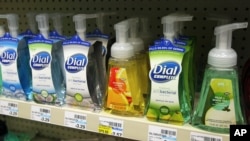Many chemicals have been linked to the development of cancer, but the cancer-causing potential of thousands of others is unknown. Now researchers have developed a simple test that can identify which chemicals have negative long-term health effects.
There are some 80,000 chemical compounds on the market worldwide. They are used in a wide variety of products from pharmaceuticals and pesticides, to water repellents and fire retardants in fabrics and carpeting. But experts say fewer than two percent of the chemicals in commercial use have been tested for their carcinogenicity, or ability to cause cancer with long-term exposure, because testing is time-consuming and expensive.
Now, researchers with Boston University in Massachusetts have developed what they hope will become a simple and inexpensive test to determine the cancer-causing potential of tens of thousands of chemicals.
“And basically [this] will help both the regulatory agencies as well as the chemical producers ... optimize their production pipeline,” said Stefano Monti, an expert in computational biology and cancer genomics with BU's Bioinformatics Program.
He says investigators, including researchers from the BU's schools of medicine and public health, along with the (U.S.) National Toxicology Program, studied data from laboratory rats exposed for a few days to chemicals known to cause cancer. They noted which genes in the animals' cells switched on and off, and compared the short-term effect of exposure to these chemicals to some 100 safe compounds.
Monti says measuring the impact of limited exposure is a way to gauge a chemical’s cancer-causing potential from the beginning.
“I think that the tools ... we are developing are going to be seen as part of a toolbox that will be deployed in order to actually prioritize what are the compounds that need to be further tested ... because of their potential carcinogenicity, toxicity and so forth,” he said.
The chemicals that were tested included dioxin, a highly toxic environmental pollutant known to cause a wide range of human health problems, including cancer; polychlorinated biphenyls (PCBs), a class of chemical compounds linked to increased rates of skin, brain and liver cancer; and bisphenol A, or BPA, an ingredient in plastics and epoxy resins that exhibits hormone-like properties.
Despite a ban on many products containing these compounds, especially in the United States, they are still commonly present in the environment.
Besides the test's predictive value, Monti says researchers want to understand how these compounds actually cause the cellular changes that can lead to cancer.
He also says it’s not known whether short-term changes in genes — as detected in the laboratory — ultimately lead to development of cancer.
Researchers published their findings in the online journal PLoS ONE.





